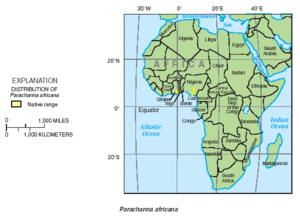African snakehead facts for kids
Quick facts for kids African snakehead |
|
|---|---|
 |
|
| Parachanna africana, after Boulenger, 1916 | |
| Conservation status | |
| Scientific classification | |
 |
|
| Distribution of Parachanna africana. | |
| Synonyms | |
|
The African snakehead or Niger snakehead, also known as Parachanna africana, is a type of fish found in west-central Africa. Not much is known about its life, but it lives mostly in coastal parts of rivers. Like other snakeheads, it is thought to build nests and hunt by quickly attacking its prey.
This fish naturally lives in southern Benin and southern Nigeria. You can find it mainly in the Oueme River and the Niger River basin.
People in Nigeria sometimes eat this fish. It is also used in traditional medicine. The African snakehead is not often kept as a pet in aquariums.
Contents
What Makes the African Snakehead Special?
Sometimes, the African snakehead is confused with a similar fish called P. obscura. But you can tell them apart by looking at these features:
- Unique Pattern: The African snakehead has 8 to 11 dark, V-shaped marks along its body. These marks start behind its gill cover.
- Scales: It has 19 to 24 scales across its body.
- Lateral Line: Its lateral line (a sensory organ) has 73 to 83 pores.
- Fin Rays: It has 32 to 35 rays in its anal fin.
Sometimes, the V-shaped marks might not be easy to see on a live fish. This can depend on the fish's mood.
How to Describe the African Snakehead?
Body Shape and Color
The African snakehead has a long body that gets narrower towards its tail. Its head is a bit flat at the front and covered with larger scales. The lower jaw is slightly longer than the upper jaw. It has 3 to 4 strong, pointed teeth. Its dorsal fin (the one on its back) has 45 to 48 rays.
The body color can be light to dark grey. The back and top of the head are darker, while the underside is lighter. It has a dark band on its head that gets wider behind its eye and gill cover. There is also a large, round black spot there. A small, round black spot is also found on its caudal fin (tail fin).
Where Does the African Snakehead Live?
P. africana lives in freshwater. It is a benthopelagic species, meaning it lives near the bottom and in the open water. You can find them mostly in lowlands, coastal river basins, swamps, lakes, and man-made reservoirs.
Caring for an African Snakehead in an Aquarium
If you keep this fish in an aquarium, it likes a dimly lit tank. It prefers to have plants floating on the surface, like Ceratopteris spp. It also needs places to hide underwater.
Important Tank Setup Tips
It's very important to use a lid that fits tightly on the aquarium. Parachanna spp are known for being able to escape! You should also leave a small gap between the water surface and the lid. This is because these fish need access to a layer of humid air above the water.
Water Conditions
The water in the tank should be:
- Temperature: Around 20–25 degrees Celsius.
- pH: Between 5.0 and 7.5.
- Hardness: Between 36 and 268 ppm.
What Does the African Snakehead Eat?
P. africana is an ambush predator. This means it hides and then quickly attacks its prey. In nature, it eats smaller fish and insects without backbones (invertebrates). In an aquarium, it usually learns to eat dead food. Some fish might even eat dried food, but this should not be their main diet.
Feeding Young and Adult Fish
- Young fish can eat bloodworms, small earthworms, or chopped prawns.
- Adult fish will eat strips of fish meat, whole prawns, mussels, live river shrimps, and larger earthworms.
Older fish do not need to be fed every day. Feeding them 2 to 3 times a week is enough.
Important Note: You should never feed this fish meat from mammals or birds, like beef heart or chicken. These meats contain fats that the fish cannot digest properly. This can lead to too much fat in their bodies and even damage their organs.
Are Male and Female African Snakeheads Different?
Yes, adult male African snakeheads are a bit slimmer and smaller than females. Males also have a longer, narrower head shape. Their unpaired fins (like the dorsal and anal fins) are slightly longer.
How Do African Snakeheads Reproduce?
P. africana lays its eggs among floating plants. The eggs float at the surface of the water. The male fish then guards the eggs. During the wet season, which is when they are most active in reproducing, the fish become much darker, almost blackish.


